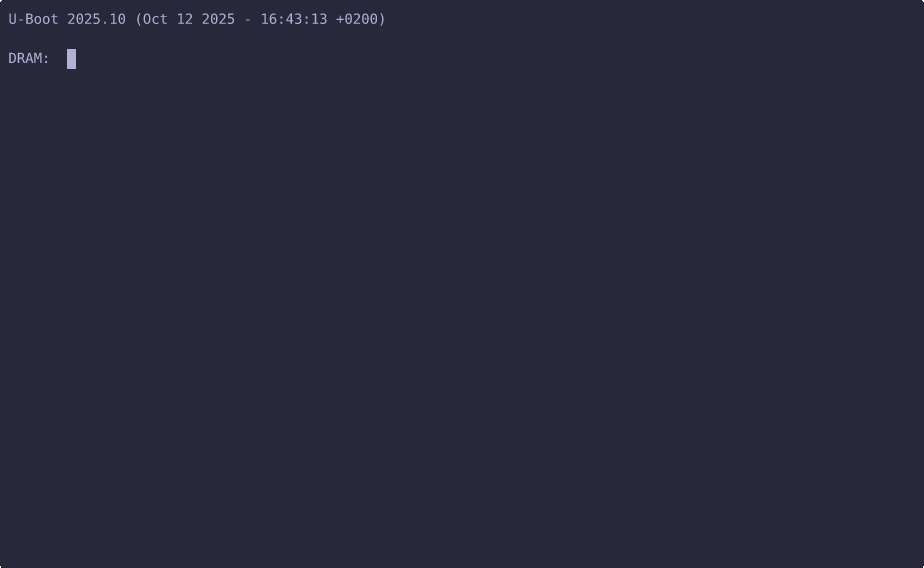Running Mainline Linux Kernel In Stm32f429i Disc1 Evk
STM32F429I-DISC is an evaluation kit based on STM32F429ZIT6 high-perfomance MCUs with Cortex-M4 core (MMU-less). Mainline Linux has support for MMU-less systems like this microntroller. In addition, it includes support for this evk.

There are at least four elemetnts of embedded Linux which are:
- Toolchain: This is the cross compiler and other tools needed to create code for our target. We are going to armv7m–uclibc–stable-2025.08-1 from Bootlin.
- Bootloader: This program initilzies the board/peripherals. We are going to use U-Boot 2025.10.
- Kernel: The heart of the system, we are going to use Linux 6.17.
- Root filesytem: This contains the librarteis and programs that are run once the kernel has completed its init. In this case we are going to use a ramdiskfs based on busybox 1.36.
Table of contents
Toolchain
Obtaining a toolchain can be as simple as downloading and installing a TAR file or it can be as complex as building the whole thing from source code, check [1] for more info. An standard GNU toolchain consists of three at least of three components:
- Binutils
- GCC
- C library (glib, musl, uClib-ng)
Here, we are going to use just the armv7m–uclibc–stable-2025.08-1 from Bootlin.
wget https://toolchains.bootlin.com/downloads/releases/toolchains/armv7m/tarballs/armv7m--uclibc--stable-2025.08-1.tar.xz
Bootloader
U-Boot supports a good number of processor architecutures and it is ubiquitous these days.
git clone https://github.com/u-boot/u-boot.git -b v2025.10
make ARCH=arm CROSS_COMPILE=arm-buildroot-uclinux-uclibcgnueabi- stm32f429-discovery_defconfig
make ARCH=arm CROSS_COMPILE=arm-buildroot-uclinux-uclibcgnueabi- -j 8
Once you build the U-boot, you could use st-flash util to flash the MCU.
st-flash write u-boot.bin 0x08000000
The idea here is to use XMODEM/YMODEM protocol to transfer the kernel, dtb and ramdisk to the external SDRAM.
Kernel
git clone https://github.com/torvalds/linux -b v6.17
make ARCH=arm CROSS_COMPILE=arm-buildroot-uclinux-uclibcgnueabi- stm32_defconfig
make ARCH=arm CROSS_COMPILE=arm-buildroot-uclinux-uclibcgnueabi- -j 8 uImage LOADADDR=0x90000000
make ARCH=arm CROSS_COMPILE=arm-buildroot-uclinux-uclibcgnueabi- dtbs
By default stm32_defconfig is configured to be used as XIP (eXecute-In-Place). However, in this case the idea is to load the kernel into external RAM, so you need to disable that. You could disable by invoking menuconfig.
From here, you got:
arch/arm/boot/uImage–> Kernel with U-Boot headerarch/arm/boot/dts/st/stm32f429-disco.dtb–> Device tree blob for this board
Root filesytem
To create a minimal root filesystem, you need the following components:
- init: This is the program that starts everything off.
- shel: Provides a command prompt and executes shell scripts.
So, here we use busybox:
git clone https://github.com/mirror/busybox.git -b 1_36_1
make ARCH=arm CROSS_COMPILE=arm-buildroot-uclinux-uclibcgnueabi- defconfig
make ARCH=arm CROSS_COMPILE=arm-buildroot-uclinux-uclibcgnueabi- -j 8
Here, we are going to use a minimal ramfs. When you are working with a MMU-less device, this means that the kernel is not able to support regular ELF files. So, this support a format called Binary flat format (BINMFT_FLAT). So, there is a tool called elf2flt. You don’t need to worry about this because it is already include in the toolchain. However, it is interesting if you want to get more details about how everything works.
mkdir -p rootfs/{bin,sbin,etc,proc,sys,usr/{bin,sbin},dev,tmp}
cp busybox rootfs/bin/
cd rootfs/bin
for i in sh ls cat mount echo dmesg ps; do ln -s busybox $i; done
Minimal init
cat > rootfs/init <<'EOF'
#!/bin/sh
mount -t proc none /proc
mount -t sysfs none /sys
echo "=== Minimal rootfs started ==="
exec /bin/sh
EOF
chmod +x rootfs/init
Device nodes
sudo mknod rootfs/dev/console c 5 1
sudo mknod rootfs/dev/null c 1 3
Pack into a cpio archive
cd rootfs
find . -print0 | cpio --null -ov --format=newc --owner root:root | gzip -9 > ../rootfs.cpio.gz
Create a ramdisk with a U-boot header
mkimage -A arm -O linux -T ramdisk -a 0x90300000 -e 0x90300000 -n "Tiny ARM Initramfs" -d rootfs.cpio.gz uInitrd
Booting the board
At this point you need:
uInitrduImagestm32f429-disco.dtb
Here, as we said before we are going to use the builtin YMODEM functionality in U-boot. So, basically, we did this:
Load kernel, here you could use minicom or any YMODEM complainant tool.
loady 0x90000000
Load dtb
loady 0x90200000
Load ramdisk
loady 0x90300000
Last step, boot the board
boot 0x90000000 0x90300000 0x90200000
Remember that your bootargs variable shall be something like this:
bootargs=console=ttySTM0,115200 root=/dev/ram0 rdinit=/init
In addition, you could saveenv and also help with some auxiliary variables in order to help you in load faster the componets.